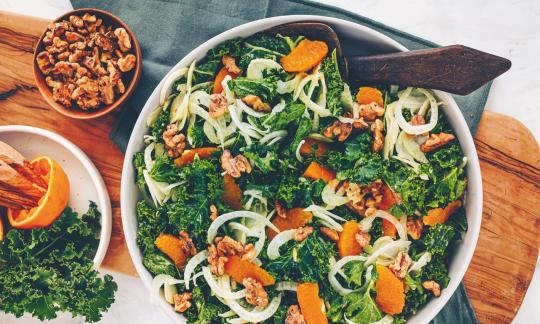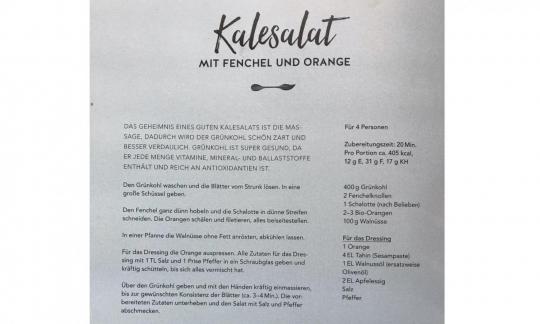Kale salad with fennel, orange and walnuts
vegan
Ingredients (for servings, )
| For the salad | |
|---|---|
| 14 oz | Kale, raw (spring cabbage, organic?) |
| 2 | Fennel (bulbs, raw, organic?) (20 oz) |
| 1 | Shallots, raw (organic?) (0.70 oz) |
| 3 | Oranges, raw, (organic?) (14 oz) |
| 3 ½ oz | Walnuts (tree nuts), raw (organic?) |
| For the dressing | |
| 1 | Oranges, raw (organic?) (4.6 oz) |
| 4 tbsp | Tahini (sesame butter, raw?, organic?) (2.1 oz) |
| 1 tbsp | Walnut oil (cold pressed?, raw?, organic?) (0.48 oz) |
| 2 tbsp | Apple cider vinegar (raw?, organic?) (1.0 oz) |
| 1 dash | Table salt (table salt, raw?, organic?) (0.01 oz) |
| 1 dash | Black pepper (organic?, raw?) (0.00 oz) |
Equipment
- mandoline
- skillet (frying pan)
- stove
- citrus juicer (lemon squeezer)
- salad spinner
Type of preparation
- chop or grind
- squeeze
- dry roast
- slice
Preparation
For the salad
Wash the kale, dry it, spin it and remove the leaves from the stalk. Place in a large bowl.Slice the fennel very thinly and cut the shallot into thin strips. Peel and fillet the oranges. Put everything aside.
The original recipe uses 2-3 organic oranges for 4 servings.
Roast the walnuts in a pan without fat and let them cool.
Raw food: To prepare the recipe raw, skip this step.
For the dressing
For the dressing, squeeze the orange. Put all the ingredients for the dressing into a screw-top jar with salt and a pinch of pepper and shake vigorously until everything is mixed.The author uses 1 teaspoon of salt for 4 servings. We have deliberately reduced this amount for health reasons - you decide for yourself according to your taste.
preparing the salad
Pour the dressing over the kale and massage it in vigorously with your hands until the leaves reach the desired consistency (approx. 3-4 minutes). Fold in the prepared ingredients and season the salad with salt and pepper.Serve and enjoy fresh.
|
Nutritional Information per person
Convert per 100g
|
2000 kcal | |
|---|---|---|
| Energy | 442 kcal | 22.1% |
| Fat/Lipids | 29 g | 41.5% |
| Saturated Fats | 3.2 g | 16.0% |
| Carbohydrates (inc.dietary fiber) | 42 g | 15.6% |
| Sugars | 21 g | 23.6% |
| Fiber | 14 g | 54.9% |
| Protein/Albumin | 14 g | 27.7% |
| Cooking Salt (Na:157.8 mg) | 401 mg | 16.7% |
| Essential micronutrients with the highest proportions | per person | 2000 kcal | |
|---|---|---|---|
| Vit | Vitamin K | 796 µg | 1'061.0% |
| Vit | Vitamin C (ascorbic acid) | 208 mg | 260.0% |
| Min | Copper, Cu | 2.3 mg | 230.0% |
| Fat | Linoleic acid; LA; 18:2 omega-6 | 15 g | 149.0% |
| Fat | Alpha-Linolenic acid; ALA; 18:3 omega-3 | 2.9 g | 144.0% |
| Vit | Folate, as the active form of folic acid (née vitamin B9 and | 260 µg | 130.0% |
| Min | Manganese, Mn | 1.9 mg | 93.0% |
| Elem | Potassium, K | 1'522 mg | 76.0% |
| Vit | Vitamin A, as RAE | 584 µg | 73.0% |
| Elem | Phosphorus, P | 390 mg | 56.0% |
Detailed Nutritional Information per Person for this Recipe
The majority of the nutritional information comes from the USDA (US Department of Agriculture). This means that the information for natural products is often incomplete or only given within broader categories, whereas in most cases products made from these have more complete information displayed.
If we take flaxseed, for example, the important essential amino acid ALA (omega-3) is only included in an overarching category whereas for flaxseed oil ALA is listed specifically. In time, we will be able to change this, but it will require a lot of work. An “i” appears behind ingredients that have been adjusted and an explanation appears when you hover over this symbol.
For Erb Muesli, the original calculations resulted in 48 % of the daily requirement of ALA — but with the correction, we see that the muesli actually covers >100 % of the necessary recommendation for the omega-3 fatty acid ALA. Our goal is to eventually be able to compare the nutritional value of our recipes with those that are used in conventional western lifestyles.
| Essential fatty acids | per person | 2000 kcal |
|---|---|---|
| Linoleic acid; LA; 18:2 omega-6 | 15 g | 149.0% |
| Alpha-Linolenic acid; ALA; 18:3 omega-3 | 2.9 g | 144.0% |
| Essential amino acids | per person | 2000 kcal |
|---|---|---|
| Tryptophan (Trp, W) | 0.06 g | 23.0% |
| Threonine (Thr, T) | 0.17 g | 19.0% |
| Isoleucine (Ile, I) | 0.19 g | 16.0% |
| Valine (Val, V) | 0.25 g | 15.0% |
| Leucine (Leu, L) | 0.33 g | 14.0% |
| Phenylalanine (Phe, F) | 0.22 g | 14.0% |
| Lysine (Lys, K) | 0.17 g | 9.0% |
| Methionine (Met, M) | 0.09 g | 9.0% |
| Vitamins | per person | 2000 kcal |
|---|---|---|
| Vitamin K | 796 µg | 1'061.0% |
| Vitamin C (ascorbic acid) | 208 mg | 260.0% |
| Folate, as the active form of folic acid (née vitamin B9 and | 260 µg | 130.0% |
| Vitamin A, as RAE | 584 µg | 73.0% |
| Thiamine (vitamin B1) | 0.56 mg | 51.0% |
| Vitamin B6 (pyridoxine) | 0.59 mg | 42.0% |
| Vitamin E, as a-TEs | 2.8 mg | 23.0% |
| Biotin (ex vitamin B7, H) | 11 µg | 23.0% |
| Niacin (née vitamin B3) | 3.4 mg | 21.0% |
| Riboflavin (vitamin B2) | 0.28 mg | 20.0% |
| Pantothenic acid (vitamin B5) | 0.91 mg | 15.0% |
| Essential macroelements (macronutrients) | per person | 2000 kcal |
|---|---|---|
| Potassium, K | 1'522 mg | 76.0% |
| Phosphorus, P | 390 mg | 56.0% |
| Calcium, Ca | 321 mg | 40.0% |
| Magnesium, Mg | 140 mg | 37.0% |
| Sodium, Na | 158 mg | 20.0% |
| Essential trace elements (micronutrients) | per person | 2000 kcal |
|---|---|---|
| Copper, Cu | 2.3 mg | 230.0% |
| Manganese, Mn | 1.9 mg | 93.0% |
| Iron, Fe | 4.1 mg | 29.0% |
| Zinc, Zn | 2.4 mg | 24.0% |
| Selenium, Se | 9.0 µg | 16.0% |
| Iod, I (Jod, J) | 1.8 µg | 1.0% |
| Fluorine, F | 0.01 µg | < 0.1% |
The kale salad with fennel, orange and walnuts is rich in vitamins and fiber. Can also be eaten raw, see "Alternative preparation".
Nutrient profile: According to GDA guidelines, one portion of this recipe covers far more than the average daily requirement of vitamin K, copper, vitamin C, folic acid and the essential fatty acids. The ratio of omega-6 to omega-3 fatty acids is 5:1, which is within the recommended maximum ratio of 5:1.
Kale: Kale is a fast-growing and globally widespread type of cabbage that, like cauliflower, is descended from wild cabbage. This robust winter vegetable is also known in Switzerland as kale and is one of the foods richest in vitamin C. In addition to many vitamins, kale also contains fiber and secondary plant substances. The nutrients are best when eaten raw, as is the case here. Massaging the kale ensures the desired consistency.
Fennel: Bulb and seeds of the fennel plant native to the Mediterranean and Asia Minor are used as ingredients in both raw and cooked dishes. The white to light green bulb is layered, similar to an onion, and has an intense aroma, which it owes to its high content of essential oils. The essential oils are also responsible for the health properties. Fennel supports digestion, is said to be anti-inflammatory and strengthens the stomach. The green stems of the bulb are covered with dill-like fennel greens, which can also be eaten.
Walnuts: In Central Europe, the common walnut ( Juglans regia) is particularly important. Of all known nuts, the walnut has the highest proportion of alpha-linolenic acid (ALA). It also has health benefits thanks to its high levels of tocopherols (forms of vitamin E) and many macro and trace elements.
Tahini: The nutty-tasting sesame butter known as tahini is made from sesame seeds processed into a kind of paste. It is also available in raw form, where the sesame seeds are placed in water without being roasted, and in the commercially available roasted form.
Reduce tahini: Since tahini has a very high proportion of omega-6 fatty acids and therefore a poor ratio of omega-6 to omega-3 fatty acids, you can significantly reduce the content of omega-6 fatty acids by using a slightly smaller amount. Please read the following link: Vegans often eat unhealthily. Avoidable nutritional errors.
Recipe as raw food: Due to the roasting of the walnuts, the dish cannot be described as raw. However, you can simply omit the roasting. If you use tahini in raw food form, you will get a raw food dish.





